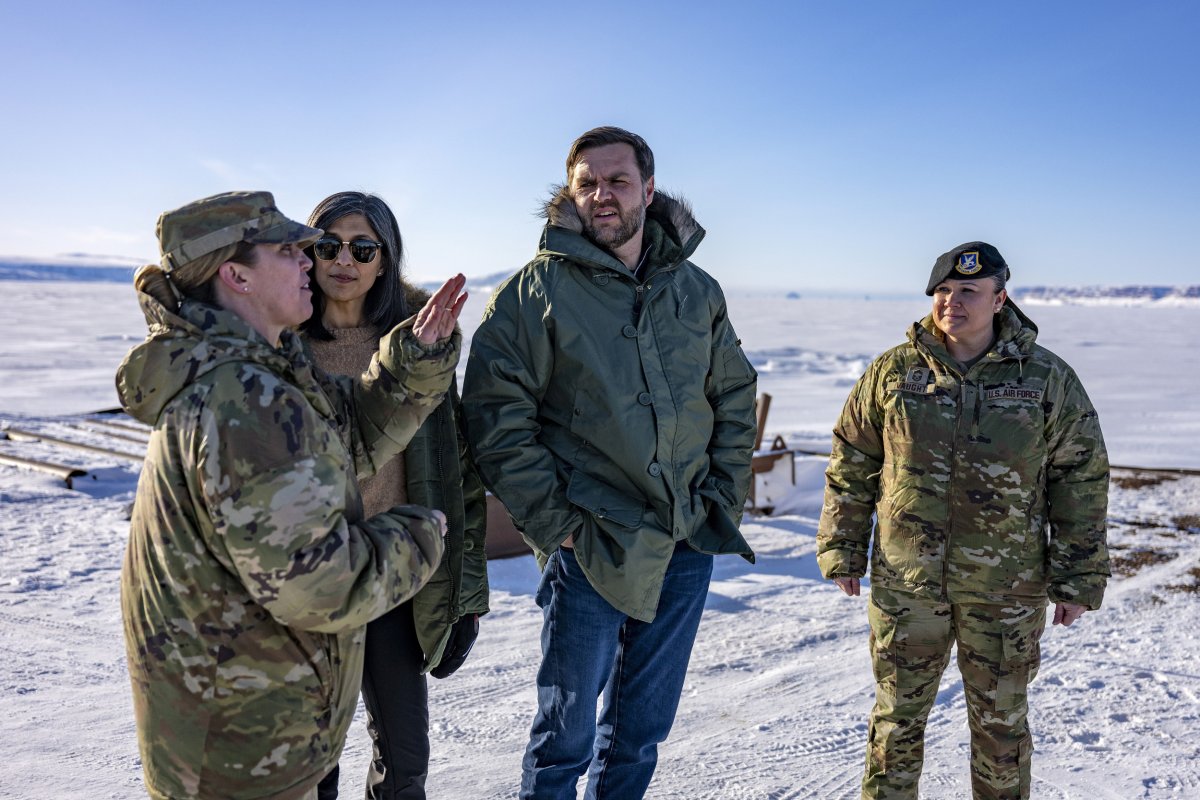Danish Prime Minister Mette Frederiksen will arrive in Greenland on Wednesday for a three-day visit to bolster relations with local leaders, as tensions rise over efforts by President Donald Trump’s administration to bring the Arctic island under U.S. control.
Why It Matters
Frederiksen’s visit comes just days after U.S. Vice President JD Vance toured the U.S. Pituffik Space Base in Greenland and accused Denmark of underinvesting in the strategic territory.

LUDOVIC MARIN/AFP via Getty Images
What To Know
Frederiksen is expected to meet with newly installed Greenlandic Prime Minister Jens-Frederik Nielsen and the Cabinet, the Naalakkersuisut.
Her trip follows a March election in which Nielsen’s Demokraatit party emerged as the dominant force in Greenland’s parliament.
The island, an autonomous part of the Kingdom of Denmark, has long been of interest to Washington due to its location and untapped resources, including highly-prized rare earths.
Amid growing geopolitical competition in the Arctic, the visit by Frederiksen seeks to shore up unity within the kingdom and reinforce Greenland’s place within it.
For years, the people of Greenland, with a population of about 57,000, have been working toward eventual independence from Denmark.
Trump has reignited calls for American sovereignty over the mineral-rich island, saying it is critical to national security.
The push by the U.S. to assert control over Greenland is testing diplomatic ties between NATO allies and raising alarm across Europe at a time when trans -Atlantic relations are under heavy strain over issues such as trade and defense.
Trump has described U.S. control of Greenland as “an absolute necessity” for national security, a stance that experts say could fracture the trans-Atlantic alliance.
The Trump administration has not ruled out using military force, although the White House insists it hopes to reach an agreement through negotiations.
White House threats to take control of the island one way or the other, possibly even with military force, have angered many in Greenland and Denmark.
The incoming government wants to take a slower approach on the question of eventual independence, and polls show there is very little desire among Greenlanders for it to become a U.S. state.

Jim Watson – Pool/Getty Images
Nielsen, who was sworn in as Greenland’s prime minister last week, issued a strong rebuke to Trump’s ambitions in a Facebook post.
“Let me make this clear: The U.S. is not getting [Greenland]. We don’t belong to anyone else. We decide our own future… It was like that yesterday. That’s how it is today. And that’s how it will be in the future,” Nielsen wrote.
Vance said of Denmark during his visit: “You have underinvested in the people of Greenland and you have underinvested in the security of this incredible, beautiful landmass.”
Danish officials rejected those claims. Foreign Minister Lars Løkke Rasmussen responded to the message: “We do not appreciate the tone in which it is being delivered.” He added: “This is not how you speak to your close allies”.
Despite tensions, Denmark has signaled openness to expanding U.S. military presence within the framework of a 1951 defense agreement.
Rasmussen noted that while the U.S. once had 17 bases in Greenland, it now operates only the Pituffik base with about 200 soldiers.
What People Are Saying
Danish Prime Minister Mette Frederiksen acknowledged the pressure on Greenland, stating in a post on social media: “President Trump’s interest in Greenland is not going away… They know very well that Greenland is not for sale. They know very well that Greenland doesn’t want to be part of the United States. It has been communicated unambiguously to them both directly and in public.”
President Donald Trump remained defiant, telling NBC News: “We’ll get Greenland. Yeah, 100 percent.” He declined to rule out the use of military force, saying: “I don’t take anything off the table.”
Jim Townsend, former deputy assistant secretary of defense for European and NATO policy, told Newsweek last week: “It would be just a horrendous catastrophe for the trans-Atlantic relationship, or NATO or U.S. relations with Europe and the rest of the world. It would hand a huge victory to Russia and to China.”
Experts remain skeptical of any legal path forward. Legal scholar William C. Banks, who specializes in national security law at Syracuse University, called the idea of Greenland becoming a U.S. state “almost surely a pipe dream of Trump.”
“Greenland would have to request statehood, itself a ridiculously remote prospect,” he told Newsweek last week.
“Clashes with Denmark and the EU would be legion, and if the U.S. attempted to take Greenland by force it would be waging an unlawful war.”
What’s Next
Frederiksen’s visit is expected to focus on strengthening political and economic ties between Copenhagen and Nuuk, Iceland’s capital, while addressing growing calls for Greenlandic independence.
The U.S. administration has made clear it will not abandon its ambitions. Trump said in a speech that he “strongly supports” Greenland’s right to determine its future and that the U.S. would “welcome” it as a new state if it chose that path.
Meanwhile, demonstrations in Nuuk suggest widespread local opposition. Protesters have carried “Make America Go Away” hats and signs reading, “Yankee Go Home.”
With the Trump administration continuing to escalate its rhetoric, Greenland’s political future—and its ties to both Denmark and the U.S.—remain uncertain.
This article includes reporting by The Associated Press.


